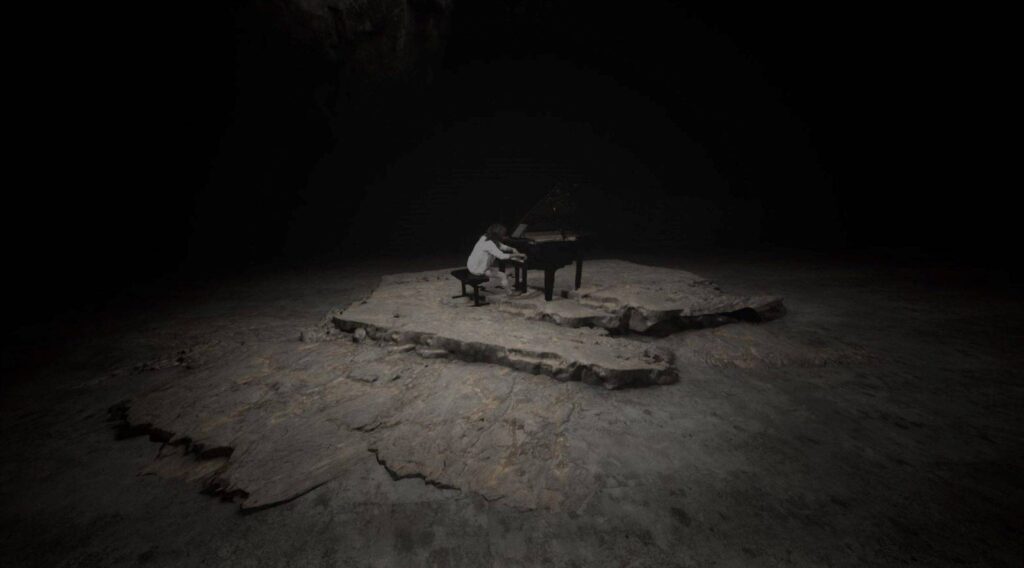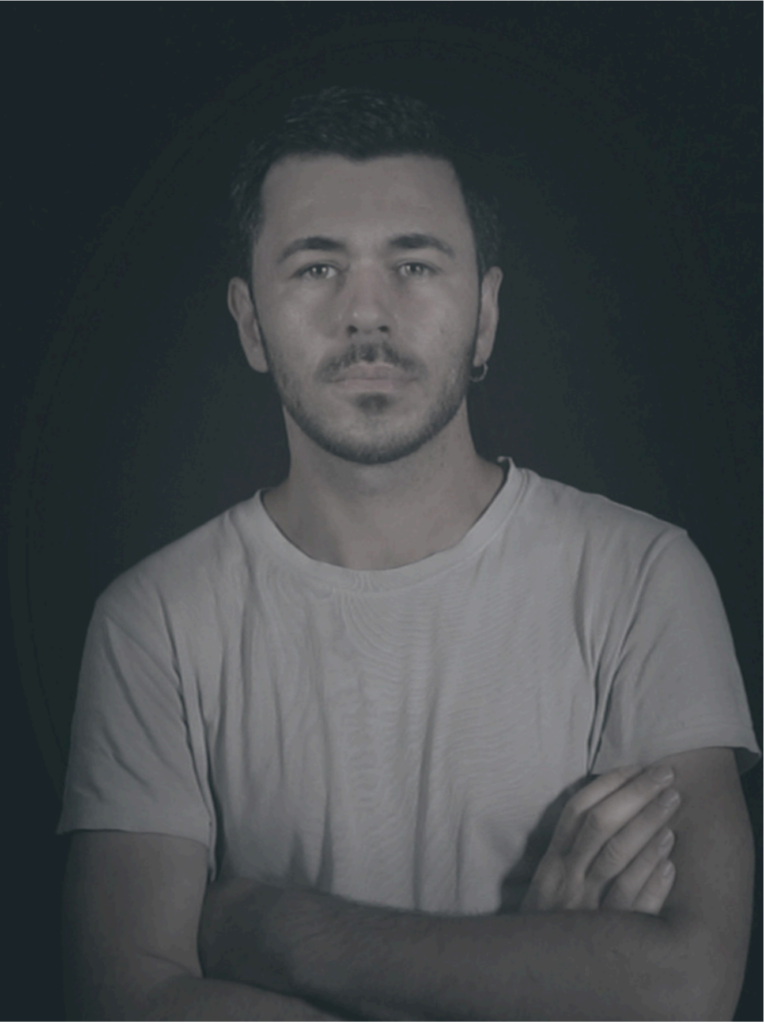Interview by Fanny Bauguil (VIDEOFORMES relay teacher)
- How would you describe this installation? What do we see? What do we hear? What do we do?
Sabia-VR is a virtual reality scenographic adaptation of the eponymous piece by composer Juan Arroyo. The installation is composed of several scenographic elements. A virtual reality headset provides access to the simulated environment. This plunges us into a mountainous cove bordered by abandoned industrial buildings. The viewer is invited to move freely within this setting. At the start of the work, the site is plunged into semi-darkness, before gradually revealing itself, highlighting the four performers of the musical piece: Benoît Poly on percussion, Hilomi Sakagushi on piano, Sylvain Millepied on transverse flute, Marie-Bernadette Charrier on saxophone, Christophe Havel interpreting the electronic sources. As in a video game, the spectator’s movement within the simulated set enables sound sources to be spatialized in real time. This dynamic mix is broadcast throughout the installation. The individual viewpoint of the viewer-listener is broadcast simultaneously into a wooden video box, placed on a table, also made of wood and of fairly ordinary construction. This scenographic choice, playing on a certain familiarity with the broadcast media, enables the simulated image to acquire a materiality akin to a miniature stage or diorama.
- Is this the first time this installation has been presented to the public? Can you tell us a little about the process involved in creating this work?
No. The piece has been presented on several occasions, in various versions: prototypes, finished piece. The work was commissioned by the Bordeaux-based electroacoustic music ensemble Proxima Centuri. The Proxima Centuri association is also behind the production of a stage version of Juan Arroyo’s musical work in 2019. The team contacted me to create a virtual reality adaptation of the work, and asked me to work freely on the scenography. The collaboration was a natural one, as I’d already worked with the team on two other immersive projects (Il Canto dei Suicidi, 2021; Analog, 2022).
- Which artists (in all fields) or, more generally, which art forms have inspired your creative process, and what references, if any, do you allude to in this installation?
My inspirations are manifold, ranging from film and video production (Jan Svankmajer, Alejandro Jodorowski, Martin Arnold, Daniele Ciprì and Franco Maresco, Gary Hill, etc.), through graphic production (Dado, Topor, Crumb, etc.), to certain contemporary digital achievements (Bill Seaman, Granular Synthesis, Boris Labbé, etc.). Music and sound creation as a whole also play a very important role in my creative process. In terms of form, the world staged in Sabia-VR is partly inspired by popular practices based on the principle of miniaturization, such as dioramas and votive miniatures. The space was conceived as a model, in the theatrical sense of the term. In a way, its appearance reflects the aesthetic and phenomenological characteristics of Baroque miniatures from southern Italy. I’m thinking, for example, of the famous “rocaille effect”, consisting in the assembly of prefabricated fake stones to produce mountainous concavities (a technique used by numerous miniaturists such as Caterina de Julianis and Gaetano Giulio Zumbo). The effect is a kind of virtual immersion before its time. The instrumentalists themselves are treated in a quite singular way, by eliminating their three-dimensionality: the silhouettes are as if cut from paper and arranged in their respective positions like Epinal pictures, vignettes placed on their three-dimensional supports. The result is a strange, life-size model effect, the artificiality of which is deliberately emphasized. Paradoxically, this reinforces its scenic, performative nature.
- What are the difficulties, constraints, challenges… encountered during its development?
Unexpectedly, the production stages of the work proceeded smoothly and naturally. The technical issues were quickly individualized, resulting in appropriate solutions for each one. This is not always the case, on the contrary. Indeed, this type of project, which relies essentially on the integration of multiple sources (filmed video, sound media, simulated components) and the consideration of spectator behavior, more often than not entails numerous technical and logistical obstacles (adapting sources, integrating them into processing software, exporting the project, integrating spectator behavior into the dramaturgy, etc.). Aside from aspects specific to the production of the piece’s visual and sound content, it is possible to identify a certain difficulty more specifically concerning its staging. Indeed, one of the major challenges in the conception and dissemination of works in virtual reality, usually viewed through dedicated headsets, is that of moving beyond this simple, rather restrictive, dissemination framework. To circumvent this mode of presentation, which is often disappointing in the context of a public event, we chose to simultaneously broadcast the viewpoint of the viewer-listener, equipped with the VR headset, within a wooden video box, in turn placed on a wooden table. As a result, both the image and the sound composition can be perceived by viewers without VR headsets. The feeling of familiarity that emanates from the particular construction of the set, which in certain respects evokes a certain idea of interior, ordinary space, enables the inclusion of outside spectators within the work’s own dramaturgy.
- Can you give us one or more web addresses where we can see your work?
https://www.vincentciciliato.net
https://www.instagram.com/vincentciciliato/
- A few keywords that would go well with your installation?
Réalité virtuelle, maquette, interprétation musicale, électroacoustique, anthropocène, interactivité, jeu vidéo
- A few words about your artistic career? When did you first become interested in digital art? Do you manage to make a living from your creative activity?
Since the mid-2000s, I’ve been working mainly in the field of multimedia installation. This interest in digital technologies, both sound and visual, goes back to my childhood, when I discovered old programming – and especially gaming – environments such as the Commodore 64. However, I’m now increasingly involved in drawing, which tends to contaminate the entire formal universe of my productions.
My training is mainly based on a university curriculum, punctuated by the integration of various specialized teaching and research programs such as the ARI (Atelier de Recherche Interactive) post-graduate program at the Ecole Nationale Supérieur des Arts Décoratifs de Paris, in 2005; and the Fresnoy – Studio national des arts contemporains, in 2010-12. A large part of my work focuses on the creation of fictional and allegorical spaces, questioning the tension between scenic components and physicality. The simplicity of the gestures, actions and locations used in my creations, as well as the almost systematic use of the still shot – which brings the images produced closer to pictorial or photographic permanence – are all pretexts for questioning the nature and instability of the contemporary body and its figuration through the exploration of certain of its plastic leitmotifs: gestural looping, fragmentation, hybridizations, micro-temporalities. These attributes are most often invested through the use of digital technologies, which I approach as tools of phenomenological investigation.
Since 2013, I’ve also been a teacher-researcher in the Visual Arts department of the Université Jean Monnet in Saint-Etienne, teaching Digital Arts. Fortunately, this main activity gives me a certain financial freedom to develop my artistic projects.

